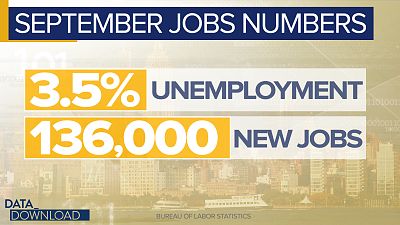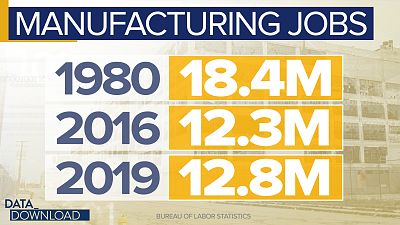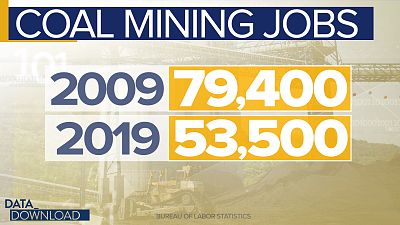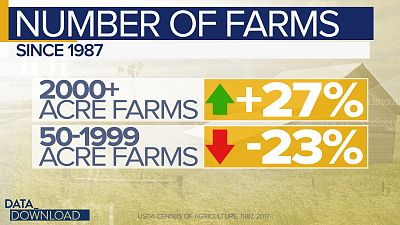"In America, the big get bigger and the small go out," said U.S. Agriculture Secretary Sonny Perdue
WASHINGTON - Friday brought some good economic news for President Donald Trump, 136,000 new jobs and a new low in unemployment at 3.5 percent in September. Those are numbers he can point to in his reelection campaign.But two-plus years into Trump's presidency, there's also a set of numbers that indicate some long-standing, problematic trends remain. And as the 2020 campaign begins those data points serve as a reminder that deeper economic change, the kind he promised in 2016, is hard to deliver.Start with the overall state of the economy and who's winning and losing in it. Yes, incomes are up and unemployment is down, but Census data released in September show income inequality not only persists, but it is also growing - even through the good economic times.
The Census data showed that the Gini Index, a measure of income inequality climbed to .485 in 2018 in the annual American Community Survey, up from .482. In the Gini, 0 equals perfect income equality and 1 equals perfect inequality and this year's number represents a new high in the ACS data.But the truth about that figure is it has been growing fairly steadily since the 1960s. The drift upward is simply not an easy trend to turn around. Changes in the job market and the structure of the U.S. economy in that time have led to a loss of middle-income jobs that propped up the middle class.Another long-term challenge exists in Manufacturing jobs, a key economic number that Trump promised to revive to levels not seen in decades. There's been some positive movement, the jobs in manufacturing are up by about 500,000 since 2016 to about 12.8 million positions. But that number is far below the millions of new manufacturing jobs that the president to create and analyses show the sector is now contracting.
Even with the growth during Trump's time in office, the number of manufacturing jobs is not back to where it was in 2008 and it is still far behind where the number was in September of 2000 when there were 17.2 million manufacturing jobs in the United States.And the truth is, this trend goes back decades. Manufacturing jobs are down 30 percent since 1980. Automation and greater factory efficiency has made this trend difficult too slow.What about coal mining jobs? Miners were a big constituency for Trump in 2016. Again, there are some small signs of improvement here. Coal mining jobs are up slightly since Trump took office, but by a very small amount - only about 2,500 positions since January of 2017. And, in the broader view, the 53,300 people employed in coal mining today is still down sharply from the 89,300 people who worked as miners back in September of 2011.
That's a drop of about 40 percent in coal mining jobs since then. And that decline is being driven by a range of factors, including alternative sources for power generation such as wind, solar and, of course, natural gas.The decline in those jobs is not a sudden story either; it has deep roots. Back in 1990, more than 130,000 people worked in coal mining.And in the heartland, where Trump won by large margins in rural areas with promises of better deals for those in agriculture, there are also long-term trends that are hitting family farms especially hard, forcing many out of business.This week U.S. Agriculture Secretary Sonny Perdue acknowledged the issue and told reporters that it's getting harder for dairy farmers to make it with smaller herds. "In America, the big get bigger and the small go out," Perdue said. "I don't think in America we, for any small business, we have a guaranteed income or guaranteed profitability."They were harsh words, but the data bear out the point of farm size.
In the last 30 years, smaller farms, those with more than 50 acres and less than 2000 acres, have seen declines, some sizable. There was a 30 percent drop among farms with between 260 acres and 1999 acres of land. But there has been a 27 percent increase in the number of large farms, those with more than 2000 acres of land.In other words, the "big get bigger and the small get out" is not a new trend under President Trump. It is the result of larger market influences that have been at work for decades, favoring larger farms that can work at a different scale.The point here is not that Donald Trump has not succeeded in these areas, it's that "success" is remarkably difficult. Other politicians have promised similar economic renaissances and failed.No one can wave a wand and bring back middle-class jobs or stop the advances of automation and alternative energy or the consolidation of farms.And despite this week's good jobs numbers, that's a challenge looming for the Trump campaign in 2020. He was elected on the promise of big economic change. That kind of talk is good campaign fodder, but it can also become a political problem if and when voters find the big changes haven't arrived.















